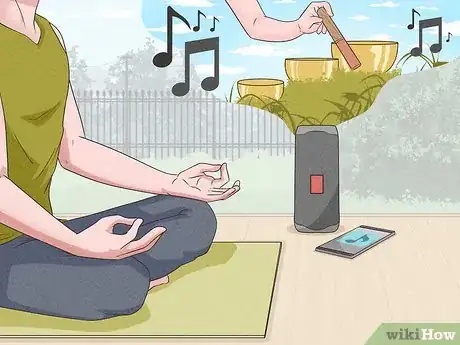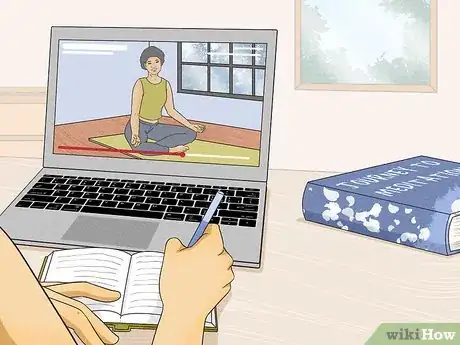This article was co-authored by Soken Graf. Soken Graf is a Meditation Coach, Buddhist Priest, Certified Advanced Rolfer, and a Published Author who runs Bodhi Heart Rolfing and Meditation, a spiritual life coaching business based in New York City, New York. Soken has over 25 years of Buddhist training experience and advises entrepreneurs, business owners, designers, and professionals. He has worked with organizations such as the American Management Association as a consultant for training courses on such topics as Mindful Leadership, Cultivating Awareness, and Understanding Wisdom: The Compassionate Principles of Work-Life Balance. In addition to his work as a priest, Soken has certifications in Advanced Rolfing from the Rolf Institute of Structural Integration, Visceral Manipulation, Craniosacral Therapy, SourcePoint Therapy®, and Cold-Laser Therapy.
There are 10 references cited in this article, which can be found at the bottom of the page.
wikiHow marks an article as reader-approved once it receives enough positive feedback. In this case, 100% of readers who voted found the article helpful, earning it our reader-approved status.
This article has been viewed 54,432 times.
Meditation has so many different benefits, including stress reduction, improved self-awareness, and increased mindfulness, but sometimes it’s hard to focus and not get distracted. Fortunately, music can really help with that. Listening to music while you meditate makes it easier to center your thoughts. The key is to choose the right type of music. Don’t worry—this article will walk you through everything you need to know to start incorporating music into your meditation routine!
Steps
Starting Your Meditation Session
-
1Find a comfortable and relaxing space. Make sure the room is a comfortable temperature for you, and that your body is comfortable where you are sitting. Choose a quiet room, so that you can focus on the music you choose.[1]
- Keep a good posture, keep your eyes closed, and relax your neck and shoulders while you meditate.[2]
-
2Eliminate distractions. Turn off the TV, and make sure you are in a room where there aren’t too many things to divert your attention to. Get pressing things done ahead of time so you won’t feel the need to worry about them while you meditate.
- Close the door and let other people in your household know that you are busy, and not to disturb you.[3]
- Turn off your cell phone or put it on silent and leave it outside of the room, or put it face down so it will not disturb you.
Advertisement -
3Use headphones or a stereo to play your music. If you choose to use headphones, it may help to feel like the music is coming from inside of your head, rather than from across the room. This can help your focus.
- Noise cancelling headphones can also help cut down distractions and allow you to focus more deeply on the music you choose to listen to while you meditate.
-
4Set aside the right amount of time to meditate. It doesn’t have to be very long—even 5 minutes will do. Adjust this time as needed, or add to it slowly over time.[4]
- Meditation is meant as a relaxation tool, so don’t stress yourself out trying to work it into your schedule. This might make it feel like an obligation or a chore rather than a relaxing activity.[5]
-
5Warm up and prepare yourself for meditation by doing yoga. Trying a few different yoga positions can help get your mind into the right state for meditation, and relax your body. It can also stretch out your muscles and help make you more comfortable.[6]
- Sukshma yoga is used specifically for relaxation. These moves do not take up much time or space, and can be done anywhere at anytime. Some sukshma yoga moves include rotating your neck slowly one way and then the other, shaking out your hands for a few minutes, and slowly opening and closing your jaw.[7]
Integrating Music Into Your Session
-
1Select the right music for you. There are many people who believe you can only use certain types of music with meditation, but that isn’t entirely true. You can really use whatever type of music you want.
- Since meditation is meant to promote mindfulness, or the state of being present and mindful of the moment you are in, any kind of music can help. Be mindful and aware of how the music makes you feel, and what you are thinking while you listen to it.[8]
- If you do have trouble meditating with music that has lyrics or loud instruments, try the more traditional meditation music, like instrumental music, meditation bells, or nature sounds.[9]
-
2Use the music as a way to center your thoughts. Finding something to focus on and hone in on when meditating can be a challenge at first. By using music, you are giving yourself something specific to focus on.
- Listening to music, all on its own, can be seen as a form of meditation. By focusing on it and being aware of yourself and your thoughts while you listen, you are essentially practicing mindfulness meditation in the process.[10]
-
3Identify how the music makes you feel. By thinking about how the music makes you feel, you’re gaining insight into your relationship with that particular song or kind of music, and this is a key in mindfulness.[11]
- There have been studies that showed that listening to music you enjoy can help your mental state and heal psychological wounds, so using music you love during meditation could be a positive addition to the practice.[12]
-
4Focus on your breathing. Breath is an essential aspect of any form of meditation. Make sure you are breathing deeply and slowly, and that you are aware of your breath as it enters and leaves your body.
- Taking a few long, slow, deep breaths can help you get started when you meditate. Focus on the part of your body where the breath is most easily felt, be it your nose, your chest, or your belly. Acknowledge the feeling of the breath coming and going from this spot.[13]
- You can even try using music with a tempo that allows you to align your breaths with the music.
Adapting to Meditating With Music
-
1Don’t worry if you have trouble focusing at first. If you are new to meditation, you might find it difficult to calm your thoughts and focus. This is normal, as meditation takes time and practice.
- The important thing with meditation is being able to redirect your thoughts back to your focus once you realize you have moved away from it. Don’t beat yourself up if you have trouble keeping your focus, just work towards redirecting it when you do lose it.[14]
-
2Decide what kind of meditation works best for you. This might mean trying multiple forms of mediation to see which one works best. This will also help you decide how to best use music in your practice.
- Different types of meditation include sound meditation, where you would repeat a personal mantra to yourself over and over, and mindfulness meditation, which focuses on breath and feeling.[15]
-
3Try different types of music each time. Each time you sit down to meditate, try a different kind of music. If soft, soothing music doesn’t work, try something with a more upbeat melody the next time. Or, if instrumental music was unhelpful, try something with lyrics.
- You don’t always have to use music traditionally associated with meditation, like nature sounds or chanting. You can use whatever music you are most comfortable listening to, even if that music is heavy metal! If you can relax and focus and gain insight while listening, then you can use it while meditating.[16]
-
4Try using music at different volumes. Many meditation guides will advise you to keep the volume relatively low, so that it doesn’t become the dominating factor of your session, and can better be used as a background noise.
- This might take some guessing and testing. Just like you will want to try different kinds of music, you will want to try different volumes as well. Make sure you aren’t listening too loudly as to hurt your ears or become uncomfortable, but not too quietly that you can’t hear it at all.
-
5Seek the advice of a meditation guide. There might be classes offered at your school or in your community, or you could find a book that details different meditation methods and how to pursue them.
- The internet is a great resource for e-books and podcasts that can help you learn both how to meditate and how to incorporate music into your sessions. There are also podcasts and digital albums that can be used for guided meditation, to listen to while you meditate.[17]
Warnings
- Avoid eating a big meal before meditating, as you might be more likely to doze off on a full stomach.⧼thumbs_response⧽
References
- ↑ Soken Graf. Certified Meditation Coach. Expert Interview. 6 March 2020.
- ↑ http://www.artofliving.org/us-en/8-tips-get-started-meditation
- ↑ https://www.mindtools.com/pages/article/distractions.htm
- ↑ https://www.psychologytoday.com/blog/in-practice/201303/5-meditation-tips-beginners
- ↑ http://www.artofliving.org/us-en/8-tips-get-started-meditation
- ↑ http://www.artofliving.org/us-en/8-tips-get-started-meditation
- ↑ http://www.artofliving.org/us-en/yoga/off-yoga-mat/sukshma-yoga-relaxation
- ↑ http://www.mindbodygreen.com/0-9117/the-3-biggest-myths-about-meditation-music.html
- ↑ http://www.mindbodygreen.com/0-9117/the-3-biggest-myths-about-meditation-music.html
- ↑ http://www.wildmind.org/background/can-anyone-meditate/music
- ↑ http://www.mindbodygreen.com/0-9117/the-3-biggest-myths-about-meditation-music.html
- ↑ http://www.mindbodygreen.com/0-9117/the-3-biggest-myths-about-meditation-music.html
- ↑ http://www.accesstoinsight.org/lib/authors/thanissaro/breathmed.html
- ↑ https://www.psychologytoday.com/blog/in-practice/201303/5-meditation-tips-beginners
- ↑ http://www.chopra.com/ccl/5-types-of-meditation-decoded
- ↑ http://www.mindbodygreen.com/0-9117/the-3-biggest-myths-about-meditation-music.html
- ↑ http://www.wildmind.org/resources



























-Step-7-Version-2.webp)

















































